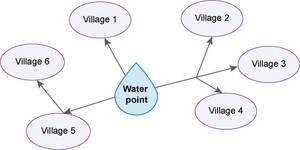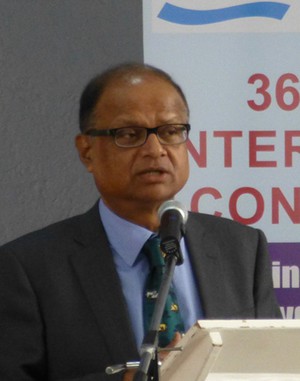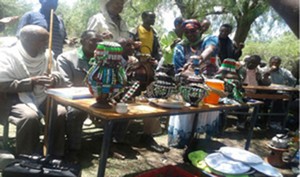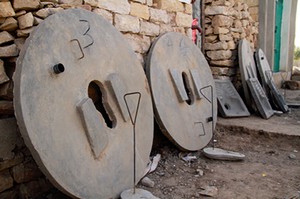Rural WASH implementation approaches
The programme for rural settings is similar to that of urban environments in some respects, but different in others. Both include providing water, sanitation and hygiene services for their respective communities as well as for health facilities and schools, but the approaches to providing these services are different because the living conditions and needs of the people are different in urban and rural settings.
Rural water supply approaches
To address the low access to water supply in rural areas the Water Resources Management Policy (MoWR, 1999) supported decentralised management, and integrated and participatory approaches to providing improved water supply services. As you have read, this policy was part of the background to the OWNP which also encourages decentralisation of management and the involvement of different stakeholders, including NGOs and communities. The recovery of operation and maintenance (O&M) costs is also recognised and supported by this policy.
What makes the Water Resources Management Policy and OWNP similar?
Both documents support decentralised management, integration and the participatory approach of both stakeholders and the wider community.
In Study Session 6, you read that the OWNP’s rural water supply activities include various studies; constructing new point sources or small piped schemes with distribution systems, including multi-village schemes where appropriate; the rehabilitation of existing point sources and expanding small piped schemes. You were also introduced to the different approaches or modalities to implement and manage these activities. We will now describe these in a little more detail.
Woreda-managed project
The woreda-managed project (WMP) is a rural WASH implementation modality in which the Woreda WASH Team (WWT) takes the lead. They are responsible for administering funds allocated to woreda, kebele or the community for capital expenditure on water supply and sanitation activities. Although the kebele administration and WASHCOs are involved in project planning, implementation, monitoring and commissioning the project, the WWT is effectively the Project Manager and is responsible for contracting, procurement, inspection, quality control and handover to the community. Typically a WMP approach is used for small schemes such as spring development, hand pumps, and the software component of sanitation. (Software components are any activities that focus on knowledge, attitude and behavioural changes of the individual or the whole community. Hardware components are the physical parts of a scheme such as well linings, pumps, latrine slabs, lavatory pans, construction materials etc.)
The construction of WMP schemes is supervised by woreda staff and projects are transferred to the community after the design and implementation stages are completed by the woreda. This has traditionally resulted in very low community participation and ownership.
Community-managed project
The community-managed project (CMP) is a rural WASH implementation approach where communities are supported to undertake all stages of a project, from initiation through planning to implementation and management continuing into the future. These projects use funds that are transferred to, and managed by, the community. The major features of the CMP approach are:
- Fund Transfer: Funds for physical construction are transferred to the communities from woredas or through intermediaries selected by the communities, thus making communities responsible during the full project cycle from planning and implementation (including procurement of most materials and labour) to O&M.
- Community Project Management: The communities, through water and sanitation committees (WASHCOs), are responsible for the full development process through planning, financial management, implementation and maintenance. The communities contribute a minimum of 15% in cash or in kind (usually labour). WASHCOs manage not only community-generated funds, but also the government subsidy provided for capital expenditures.
- Procurement: A further aspect of community management is that the WASHCO is directly responsible for procuring (buying) the goods and services required for water scheme construction and installation.
The CMP mechanism is intended mainly for low-level technologies such as hand-dug wells and spring protection. An example of a community-managed project is the Debero-Garmojo water point (Figure 10.1). Debero-Garmojo is in the Abichugena woreda, Oromia region. The water point was constructed by local community with the support of the woreda administration and the government of Finland. The water comes from a spring and is piped into a collection tank which has three taps and serves 30 households. The WASHCO was responsible for its planning, procurement, contracting, management, and operation and maintenance.


Figure 10.1 Debero-Garmojo water supply system showing (top) protected spring eye and (bottom) the cloth washing basin.
NGO-managed project
As you know by now, non-governmental organisations (NGOs) are important stakeholders in the OWNP as donors, implementers and knowledge disseminators. Their funding and management arrangements vary considerably but, combined with national WASH principles and practices, they foster community initiatives, develop community leadership and require community investment in water supply projects. In some cases, NGOs administer external resources on behalf of the community. In others, they make external resources available to the community directly or through microfinance institutions to support construction and management.
NGOs have flexibility and are able to increase community involvement, ownership and accountability. NGO-supported projects follow procedures agreed between the NGO, its partners, the Ethiopian government and the region or woreda where the activities are located. They should comply with policies on cost-sharing, community contributions, reporting and monitoring indicators. NGOs are included in resource mapping at all levels and will be requested to provide information for preparing consolidated annual WASH plans and budgets. (Resource mapping is the identification of the sources and amounts of all possible funds for a project.) NGOs will also be requested to provide periodic progress reports on their projects to WASH Coordinators at various levels.
You have already seen several examples of NGO-managed projects in this Module. As discussed in Box 9.1 in the previous study session, the term NGO may be used loosely, and in this context is frequently applied to projects managed by organisations like UNICEF and the World Health Organization (Figure 10.2), which are not NGOs in the strict sense of the term.

Figure 10.2 NGO-managed project: Well-fenced water point constructed by WaterAid at Gidachemo kebele, Sore woreda, in SNNPR.
Self-supply
Self-supply was defined in Study Session 6 as the construction and use of small-scale water schemes at household level, such as hand-dug wells. As stated in the manual prepared by Ministry of Water, Irrigation and Energy (MoWIE, 2014a) self-supply means ‘improvement to water supplies developed largely or wholly through user investment by households or small groups of households’. Self-supply involves households taking the lead in their own development and investing in the construction, upgrading and maintenance of their own water sources, water-lifting and treatment devices and storage facilities.
Multi-village water supply schemes
As the name suggests, these are schemes designed to provide water to several villages from a single source (Figure 10.3).

Figure 10.3 A multi-village water scheme system used to serve different villages.
Regions and zones are mainly responsible for this type of scheme and they undertake all the studies, design, management, construction and supervision. These schemes are more complicated and construction requires higher-level technology to serve larger populations of up to 100,000 people in the combined villages. Multi-village water supply schemes will be supported under certain conditions, provided that feasibility studies verify that the proposed sources are adequate and that the schemes can be socially, technically and financially sustainable.
Rural sanitation and hygiene promotion
Currently there are a number of different approaches to promoting rural community sanitation and hygiene in Ethiopia. We will highlight two of the most important: community-led total sanitation and hygiene, and sanitation marketing.
Community-led total sanitation and hygiene
Community-led total sanitation (CLTS) is an approach which emphasises changing the behaviour of all people in a community in order to stop open defecation and encourage good hygiene practices in and around the home. CLTS was introduced in Ethiopia following a hands-on workshop in October 2006, organised by Vita, an Irish international development agency working in the Horn of Africa, and led by Dr. Kamal Kar (Figure 10.4). The Federal Ministry of Health had taken the initiative to use this approach as the main tool to improve rural sanitation by training Health Extension Workers (HEWs) in the technique. Since that time, the approach has been developed and renamed in Ethiopia to explicitly include hygiene and is now known as community-led total sanitation and hygiene (CLTSH).

Figure 10.4 Dr Kamal Kar, developer of the CLTS approach.
The aim of CLTSH is to achieve open defecation free (ODF) status. This is awarded to villages and communities when they have achieved the situation whereby everyone has access to a latrine and no one defecates in the open at any time. The award of ODF status is cause for great celebration in the community (Figure 10.5). ODF status is achieved through a process of social awakening stimulated by facilitators from within or outside the community. The approach concentrates on the behaviour of the community as a whole rather than on individuals.

Figure 10.5 ODF celebration in Dugda woreda, Oromia.
The CLTSH process involves trained facilitators working with communities to inspire and empower them to stop open defecation and to build and use latrines for themselves. The facilitators encourage people to take responsibility and consider their own behaviour rather than rely on external subsidies to buy hardware such as latrine slabs. Community members come together with the facilitators in group discussions to analyse the extent of open defecation in and around the village (Figure 10.6). They consider the implications of this for faecal-oral contamination and the resulting detrimental impact on human health that could affect every one of them.
The CLTSH approach works by creating a sense of disgust and shame among the community in a stage in the process called triggering or igniting. The process brings them collectively to the realisation that they quite literally will be eating one another’s ‘shit’ if open defecation continues. When they realise this shocking fact, the people become very enthusiastic about taking action to improve the sanitation situation in the community (Kar, 2005).

Figure 10.6 Community mapping of defecation areas in a village in Tigray region as part of a CLTSH process.
Sanitation marketing
Since the introduction of CLTSH, significant numbers of households have gained access to self-constructed basic latrines. However, many self-constructed latrines fall short of fulfilling the minimum standard of improved sanitation and hygiene facilities, as shown in Figure 10.7. This is one of the reasons for introducing sanitation marketing.

Figure 10.7 An example of an inadequate pit latrine.
Why is the latrine shown in Figure 10.7 inadequate?
The pit is covered with logs rather than a slab. This will not provide separation between the people using the latrine and their waste. It is unstable and difficult to find a secure footing and is likely to break and collapse while someone is using it. Also there is no proper infrastructure around the pit to provide privacy.
Sanitation marketing is a relatively new approach to improving sanitation provision and does not have a single precise definition. The Water and Sanitation Program’s Introductory Guide to Sanitation Marketing explains that ‘some practitioners define sanitation marketing as strengthening supply by building capacity of the local private sector; others discuss it in terms of “selling sanitation” by using commercial marketing techniques to motivate households to build toilets’ (Devine and Kullman, 2012).
In Ethiopia, the National Sanitation Marketing Guideline defines sanitation marketing as ‘satisfying improved sanitation requirements (both demand and supply) through social and commercial marketing process as opposed to a welfare package’ (MoH, 2013). The national guideline sets out three pillars for the approach which are:
- Strengthening an enabling environment for sanitation marketing programme.
- Creating access for improved sanitation technology options.
- Generating demand for improved sanitation technology options (MoH, 2013).
In practice this approach includes a range of different activities that encourage people to build latrines and adopt good hygiene behaviour and also to create business and commercial opportunities. An important feature is that new sanitation services are not provided for free. Figure 10.8 shows an example of a sanitation marketing enterprise where latrine slabs are constructed for sale.

Figure 10.8 New slabs for VIP latrines ready for sale.